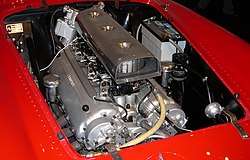Ferrari Lampredi engine

Aurelio Lampredi designed a number of racing engines for Ferrari. He was brought on to hedge the company's bets with a different engine family than the small V12s designed by Gioacchino Colombo.
I2
Enzo Ferrari and Lampredi were interested in creating extremely reliable engines for racing use. In 1955, after seeing the success of Lampredi's straight-4 engines, the pair considered a straight-2 engine for the slowest racing courses. Lampredi built a prototype with 4 valves per cylinder and 2493 cc of displacement. It produced 175 hp on the test bench, but broke the crankshaft due to poor balance. The project was shortly abandoned in favor of more-conventional I4 engines.
I4
Lampredi designed a straight-4 engine for Formula One and sports car racing use. The initial engine was a 2.5 L (2498 cc) unit with a 94 mm bore and 90 mm stroke. The aluminium engine produced 220 hp with 2 Weber 50 DCOA/3 carburettors. It was a high-tech marvel for the time with dual overhead camshafts pushing 2 valves per cylinder and twin-plug ignition. This version was used in the 1953 625 TF. After the Le Mans disaster, the 2.5 L I4 was resurrected for the 1956 625 LM car. Output was rated at 225 hp.
A big-bore version (102 mm) was also produced. Displacement was now 3.0 L (2942 cc) and output nudged up to 225 hp. This engine was used in the 1953 735 S sports car.
Another inline 4 was used in the 1953 500 Mondial. It was a 2.0 L (1985 cc) unit with 90 mm bore and 78 mm stroke. Again a DOHC unit, it produced 170 hp. The same engine, now at 180 hp, was used in the famous 1956 500 TR. The "red head" cylinder head lent its name to the car, the first Testa Rossa. Another TR with this engine, the 1956 500 TRC, was produced for customers to race.
The bore of the Lampredi I4 was nudged up (to 103 mm) for the 3.0 L (2999.62 cc) unit used in the 1954 750 Monza. Dual Weber 58 DCOA/3 carbs pushed out 250 hp.
For 1955, the "type 129" engine debuted in the experimental 857 S. Bore was the same 102 mm as the big-bore four, but stroke was now 105 mm for a total of 3432 cc. The engine was finally raced in the 1956 860 Monza with 280 hp. These cars placed first and second at Sebring and came second and third at Le Mans that year.
I6
For the 1955 735 LM, Lampredi modified the big-bore 1953 I4 into a straight-6. Displacement was 4.4 L (4412 cc) from 102x90 mm cylinders. Triple Weber 50 DCOA/3 carbs pushed out 300 to 350 hp. With this power, the 735 LM could hit 280 km/h on the Mulsanne straight at Le Mans.
A smaller version was used that same year in the 376 S sports car. It used the same 90 mm stroke and 94 mm bore as the original Lampredi Formula One engine and produced 280 hp.
V12
After little luck in Formula 1 with the supercharged Colombo V12, Ferrari moved to natural aspiration. The task of designing an NA V12 for Formula 1 use fell to Aurelio Lampredi, who designed a 3322 cc unit.
Like the Colombos, Lampredi engines found their way into road cars as well. The 1952 342 America and MM were first with big 4102 cc engines producing 200 and 300 hp. Lampredi engines moved to the 250 with the 1953 250 Export. Unlike the earlier engines with their undersquare 80x68 bore and stroke, the 250 used square 68 mm dimensions for 2963 cc total. Power was impressive at 220 hp.
The big America engine was made even larger for the 1956 410 Superamerica. Now with an 88 mm bore, it displaced 4962 cc and produced 340 hp. The same engine was used in 1964's 500 Superfast.